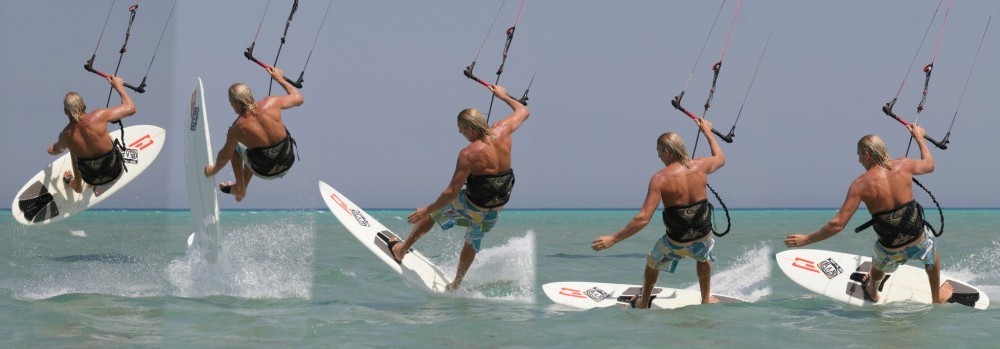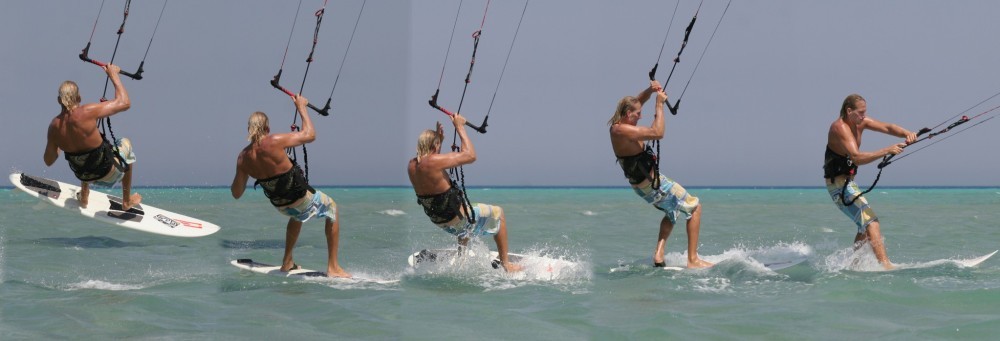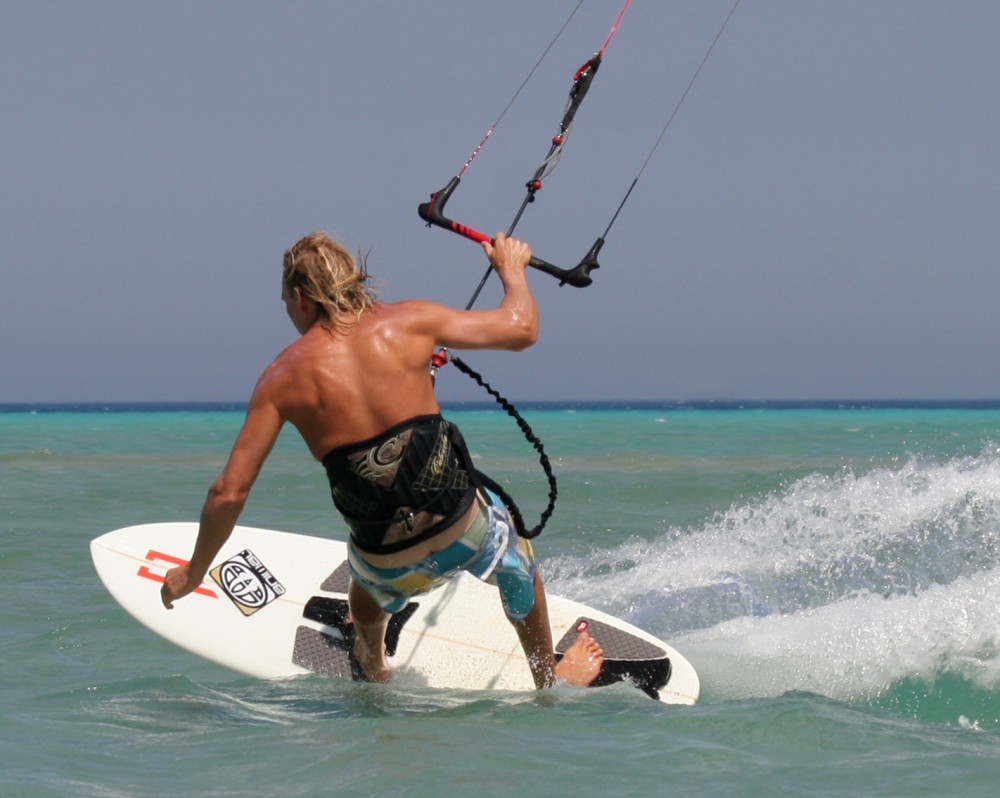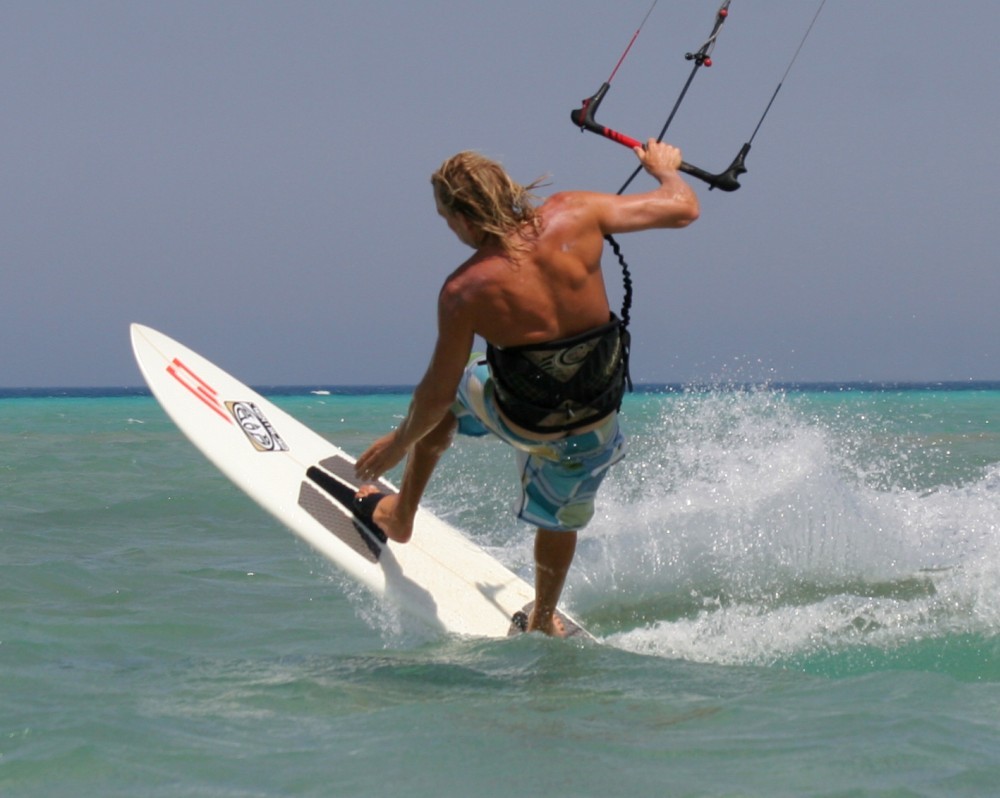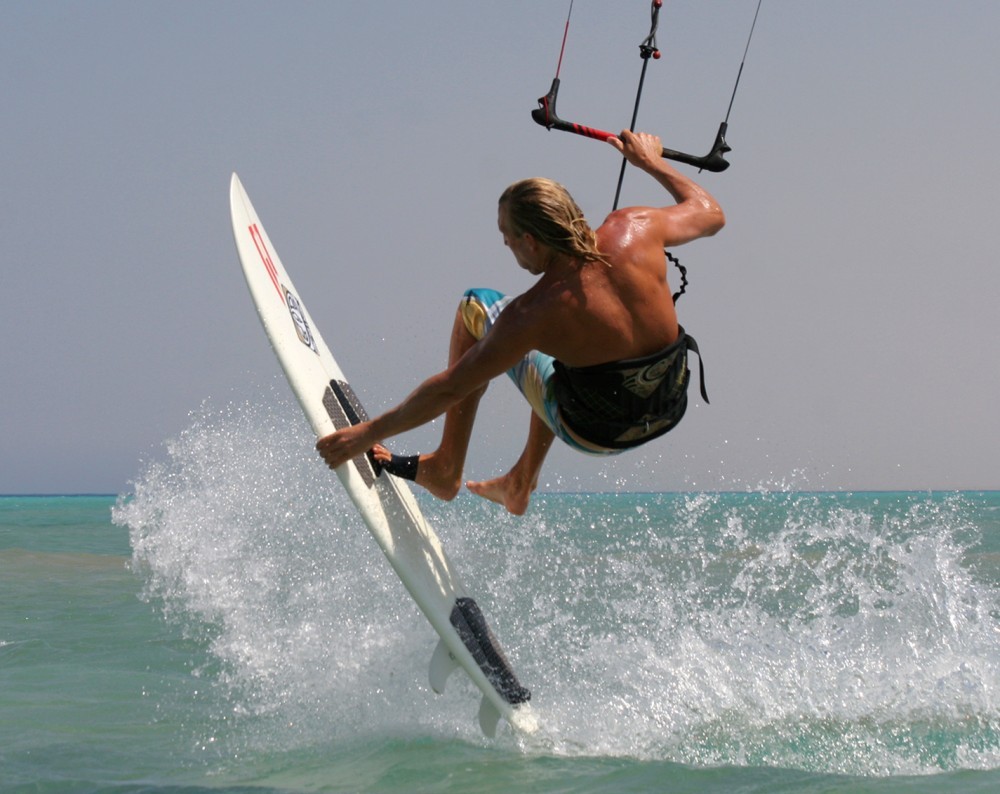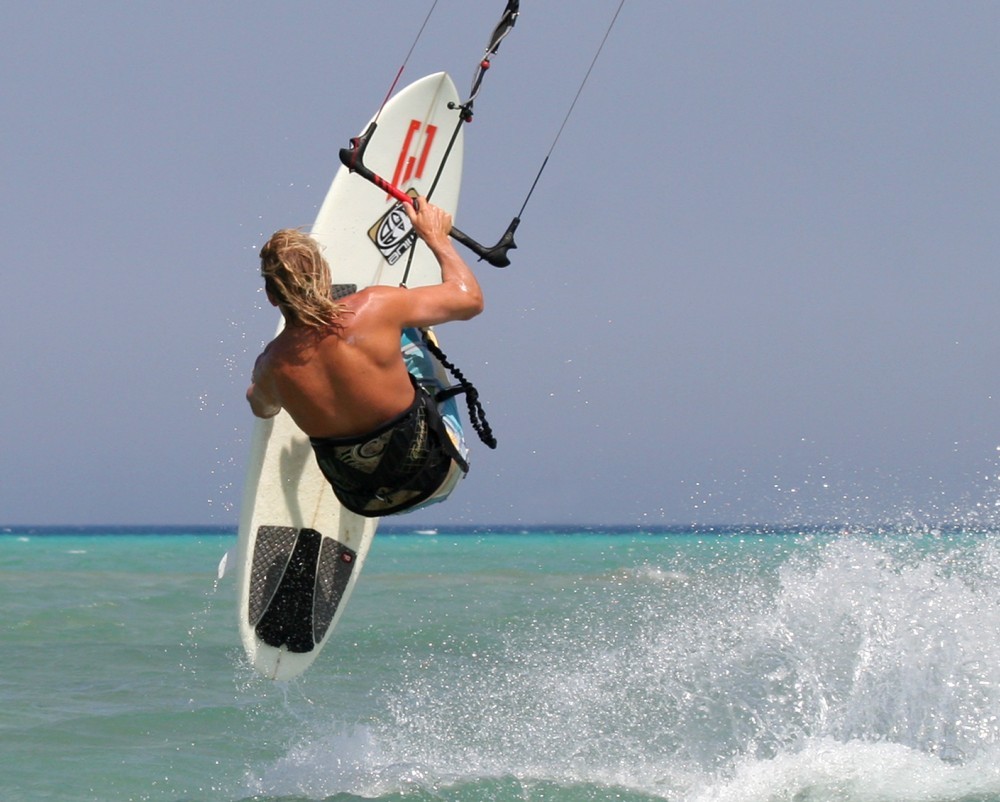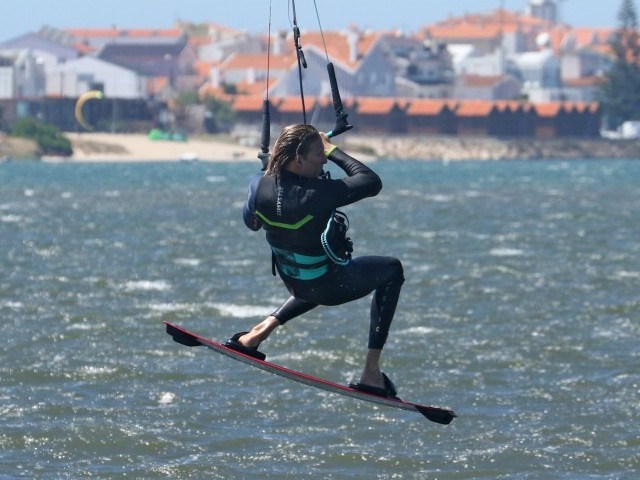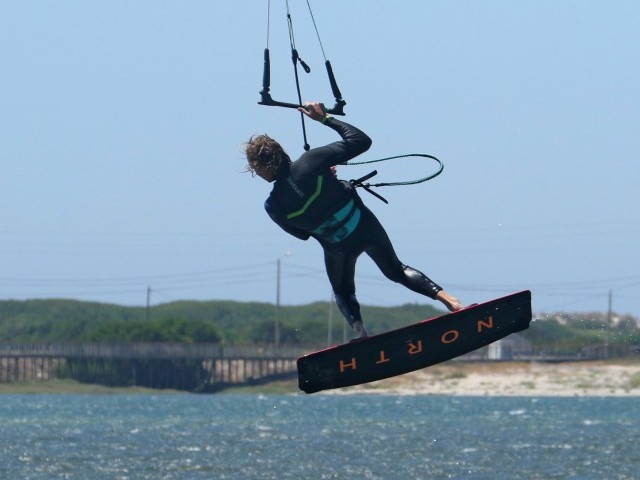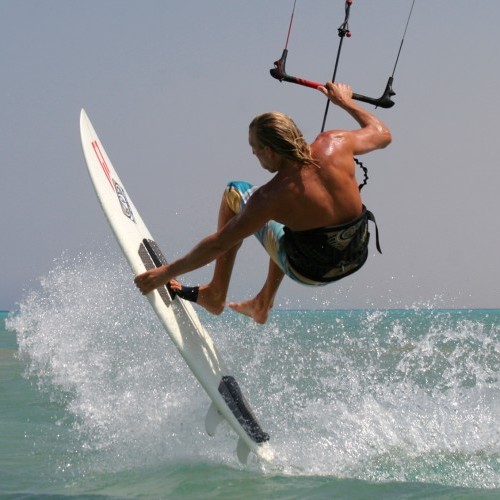
Strapless Air Gybe
Technique / Intermediate
Introduction
Now something for those of you who are happy riding a surfboard and fancy something else to do when the wind is light! Surfboard strapless freestyle is a lot of fun, doesn’t have to hurt and certainly some of the tricks really don’t take too long to learn. Anyone who has witnessed the smooth riding style of Mitu, or has been privy to watching many of the locals in Cape Verde (apologies to all other nations and Top Hat, but these guys make it look so effortless), will agree that it looks amazing. The added bonus that you can practice this when the wind is too light for anything else gives you no excuses.
To master this trick you don’t need to be uber flexible, as you’ll let the wind do the hard work. However being able to do a good air gybe on a twin tip is a must as man handling a flying surfboard is a lot easier when you don’t have to concentrate on the kite.
Before even pondering this on you surfboard there are a couple of things worth practicing on your twin tip that will make this a lot easier. Firstly is for the board grab, secondly for the kite control.
1. Spend some time popping whilst riding along and reaching forward to grab your heel side edge in between your front foot and the nose of the board. This should be pretty simple, although slightly unnatural. There are two good reasons to try this. Firstly normally when you pop you lean back over the back foot. This works well on a twin tip, but it makes it hard to get forward and grab the board. By going for the grab it will teach you to pop off your back foot with your shoulders and head leaning forwards. Secondly it means that you will be over the board when you pop, so essentially you can turn the board around and under you. If you take off leaning back, you will squirt the board away from you making it all so much more tricky.
2. Grabbed air gybes, or jump transitions as you may well know them. Doing a good air gybe whilst holding a front hand grab in the afore explained position is exactly what you’ll be doing on the surfboard, so if it doesn’t work on a twin tip… Your aim is to go into it with enough speed to move the kite back, pop up, hang, then turn and land all using your original back hand. It is preferable if you can do this without a late kite loop, but not essential.
Once you’ve got that down we can ponder what’s important with a surfboard under our feet. And then finally we’ll have a look at the timing to make it all come together harmoniously.
In the video Christian is riding an 11m Nomad on a Skillit 5’10” in very light winds. In the pictures he’s using a 9m in about 18 knots.
The Approach
If you look at the Real Time Video clip you can see that Christian comes into this trick with a fair bit of speed. There are two reasons for this. You need speed to pop so that you can get in the air before the kite pulls. And if you’re moving too slowly the wind will control your board when you pop it up (face full of fibreglass optional). With you speed you can then carve the board hard into wind, and on its edge, which then gives you something to pop against.
In Pic A. Christian is carving hard upwind just prior to popping. Firstly the feet! Christians front foot is pointing forward on the inside rail of the board. This allows him to twist his body upwind. His back foot straddles the centre line of the board near the tail. Below the foot is a lot of volume so when Christian stamps down the board will pop back with a vengeance. With his back foot near the tail Christian’s front foot is slightly further back than he would normally have it. If your legs are spread too wide it will be hard to pop, and if Christian moves his back foot forward there will be too much board under his foot to pop against and carve upwind with.
Christian has his front hand stretched out in front of him, which helps him lean forward with his head and shoulders towards the nose of the board. This is so important. If he leans back he’ll end up behind the board in the air.
As Christian steers the kite back up towards 12 o’clock with his back hand right in the centre of the bar, he lets the bar out a tiny bit. Just enough so he can carve that little bit further into wind, which means that he can take off with the board almost facing dead into the wind. This way he can use the wind to help lift the board off the water. However if you let the tension off the lines you won’t get any lift, so a bit of trial and error is needed to get a feel for this.
The Take Off
Here is where we’ll see if you’ve been practicing or not. We’ve already said that normally we lean back to take off, but here we must lean forward. This is why the pop is a tad more complicated/different. As you stamp down on your back foot the nose of the board will want to rise. However there is one thing stopping it doing so, your front foot. So as you stamp down you need to lift you front leg, in a sea saw motion.
In Pic B. you can see that Christian’s back leg is fully extended because he has stamped down hard. His front leg is bent as he lifts his knee up, which allows the nose of the board to rise up. This is actually made easier by reaching forward to try and grab the board, as your body will automatically fold up, a bit like tying your shoelace on a step. As the nose rises the wind will catch it and help it up. You do need to be cautious if the wind is strong as a light board can just fly straight back into you.
What about the kite? As with an air gybe you should be popping up just as you feel the kite start to lift. The earlier you pop the better your chances.
Grab It
To catch the board you’ll need to concentrate and focus on where you want to grab it. Ideally your hand should be around the place your front foot was, fairly central from nose to tail. If you grab it too far forward it will be difficult to turn the board and if you do you are likely to land on the nose. If you grab the board too far back, you won’t be able to control it against the wind and you’ll be forced to let go too early.
In Pic C. the important thing to emulate is the sitting position. You need to lift you back foot off the board so that it can cork back up. So as you grab the board, try to get both knees up, just as you should for a grab on a twin tip. In the picture it may look like you need to supple, but believe us Christian is not. The wind is pushing the board back towards him, so he just needs to catch it!
At this stage of play the kite should hopefully be around 12 o’clock, supporting you so you can hang under it and sort the board out.
Hold On and Chill
As the board blows back at you and you grab it, the temptation is to let it go, but if you do it’ll find its own path, and that won’t be where you’re going. Chances are that you will be swinging under the kite in the direction that you were travelling. If you let go of the board now, it’ll blow down wind, so you will miss it altogether. You need to wait until your momentum has slowed, and then you can turn to face the new way. This is just like the big chill in a normal air gybe where you keep looking forward with your bar in and wait until you slow and drop.
Pic D. shows Christian in the big chill. He holds the board away at arms length but keeps it up. Because he is sitting the board is kept from blowing past him as it rests against his feet. His aim here is to bring the board around in front of him by pulling his arm and the board across his body. Christian is still looking the way he was going and has tension on the lines.
Finding Your Under Carriage
This final step is crucial to a successful landing. As the board comes around you need to get your front foot onto the board where it should be to ride away. This isn’t a magic trick and the board will not stay there, but it does mean that the board will fall under your feet.
In Pic E. Christian is aiming to get his front foot onto the pad on the upwind side of the board, so he must hold the board up to give himself a chance. Once his foot touches the pad and he starts to drop he can release the board and drop onto it, whilst diving the kite to pull him out of the move. As he drops he will extend his legs which should keep the board in contact with his feet.
Final Thoughts
Learning this progressively is the key. So give yourself achievable goals. Start of with turning hard into wind and popping the board up to get a feel for how it flies back at you. Then try catching it and floating. Finally try turning and dropping the board under your feet. If you don’t get the first bits ingrained in your head and body you won’t be able to concentrate on the happy ending.
Following Sequence 1
- Pic 1. Riding with speed and the kite around 11 o’clock, Christian carves hard upwind, and steers the kite slowly up whilst reaching forward with his front hand.
- Pic 2. Bending forward at the waist towards the front of the board Christian stamps down hard on his back foot.
- Pic 3. To let the board rise Christian lifts his front knee, allowing the wind to get under the nose. He focuses on the rail of the board where he will catch with his open palm.
- Pic 4. As the board blows back towards him, Christian lifts his back leg and sits in the harness. Christian keeps the board up and brings his arm across his body to turn it around, keeping the kite above him around 12 o’clock. This is the big chill.
- Pic 5. Christian turns the board and gets his front foot onto the front pad where it should be. As he drops, he lets go of the board.
Following Sequence 2
- Pic 1. As Christian drops he pushes the board down underneath him by extending his legs. Christian watches the deck of the board so that he’ll land on it. Now is time to dive the kite with your new front hand.
- Pic 2. The board touches down with Christian landing on it a blink later. Because his feet pushed the board down and away from him, his weight is still committed upwind of the board.
- Pic 3. Christian lets his weight drop onto the upwind rail of the board, which lets the board slide with him, so he can push it between him and the kite.
- Pic 4. Christian pushes the nose of the board off the wind with his front foot, gets his back hand on the bar and continues to dive the kite hard.
- Pic 5. In this example Christian did not have enough power to ride out as his kite had drifted too far, so he keeps pulling to loop the kite to stop himself sinking. This will often be the case with smaller kites.
Common Problems
If you can’t grab the board you are learning to far back on take off.
If the board blows out of reach, you have not turned into wind enough before popping. Or you have let the kite go too far behind you before popping.
If you land too far forward on the board, or even on the nose of the board, hold on longer and drop the board at the last moment. Also make sure that you do not grab the board to far forward.
Keystones
- Turn all the way into wind
- Pop early
- Lift front leg and sit
- Pull arm across body to turn board
- Front foot onto board, then drop
This technique article was in Issue 22 of IKSURFMAG.
Related
By Christian and Karine
Christian and Karine have been working together as a coaching team, running improver to advanced kitesurfing clinics since 2003.






